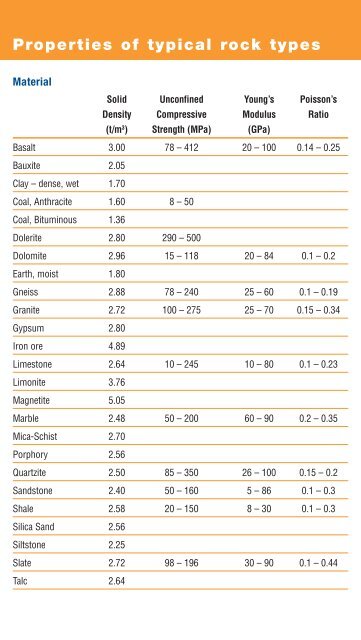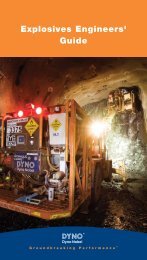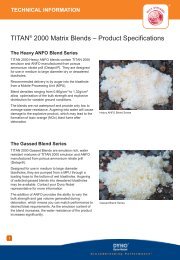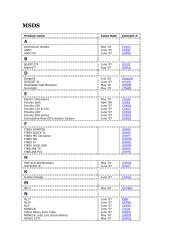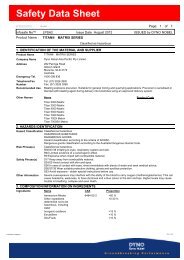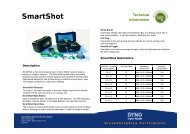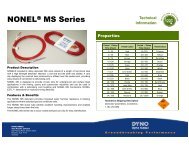Blasting and Explosives Quick Reference Guide 2010 - Dyno Nobel
Blasting and Explosives Quick Reference Guide 2010 - Dyno Nobel
Blasting and Explosives Quick Reference Guide 2010 - Dyno Nobel
Create successful ePaper yourself
Turn your PDF publications into a flip-book with our unique Google optimized e-Paper software.
Properties of typical rock types<br />
Material<br />
Solid Unconfined Young’s Poisson’s<br />
Density Compressive Modulus Ratio<br />
(t/m 3 ) Strength (MPa) (GPa)<br />
Basalt 3.00 78 – 412 20 – 100 0.14 – 0.25<br />
Bauxite 2.05<br />
Clay – dense, wet 1.70<br />
Coal, Anthracite 1.60 8 – 50<br />
Coal, Bituminous 1.36<br />
Dolerite 2.80 290 – 500<br />
Dolomite 2.96 15 – 118 20 – 84 0.1 – 0.2<br />
Earth, moist 1.80<br />
Gneiss 2.88 78 – 240 25 – 60 0.1 – 0.19<br />
Granite 2.72 100 – 275 25 – 70 0.15 – 0.34<br />
Gypsum 2.80<br />
Iron ore 4.89<br />
Limestone 2.64 10 – 245 10 – 80 0.1 – 0.23<br />
Limonite 3.76<br />
Magnetite 5.05<br />
Marble 2.48 50 – 200 60 – 90 0.2 – 0.35<br />
Mica-Schist 2.70<br />
Porphory 2.56<br />
Quartzite 2.50 85 – 350 26 – 100 0.15 – 0.2<br />
S<strong>and</strong>stone 2.40 50 – 160 5 – 86 0.1 – 0.3<br />
Shale 2.58 20 – 150 8 – 30 0.1 – 0.3<br />
Silica S<strong>and</strong> 2.56<br />
Siltstone 2.25<br />
Slate 2.72 98 – 196 30 – 90 0.1 – 0.44<br />
Talc 2.64


